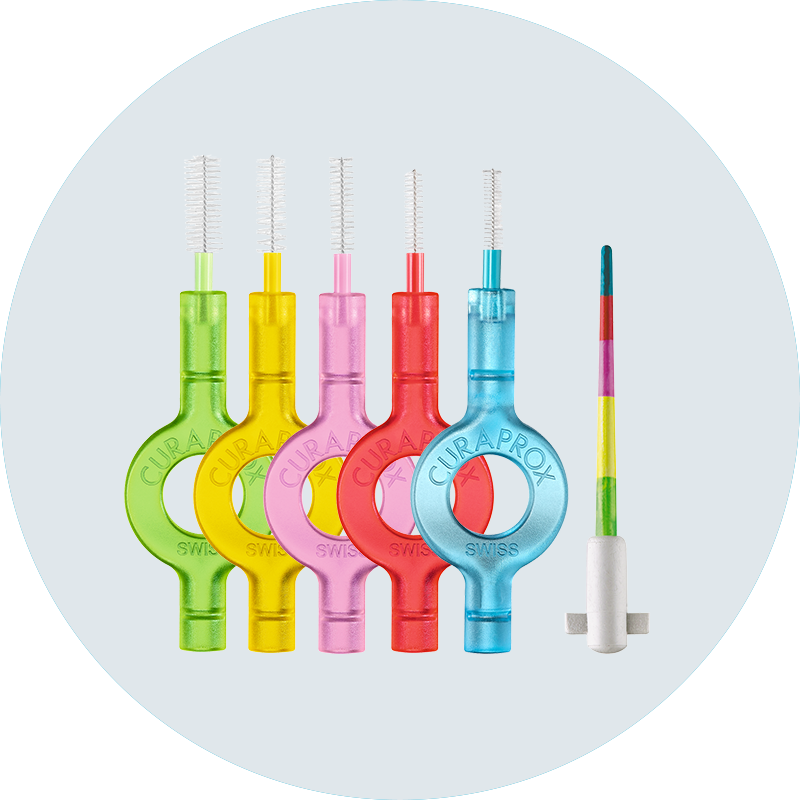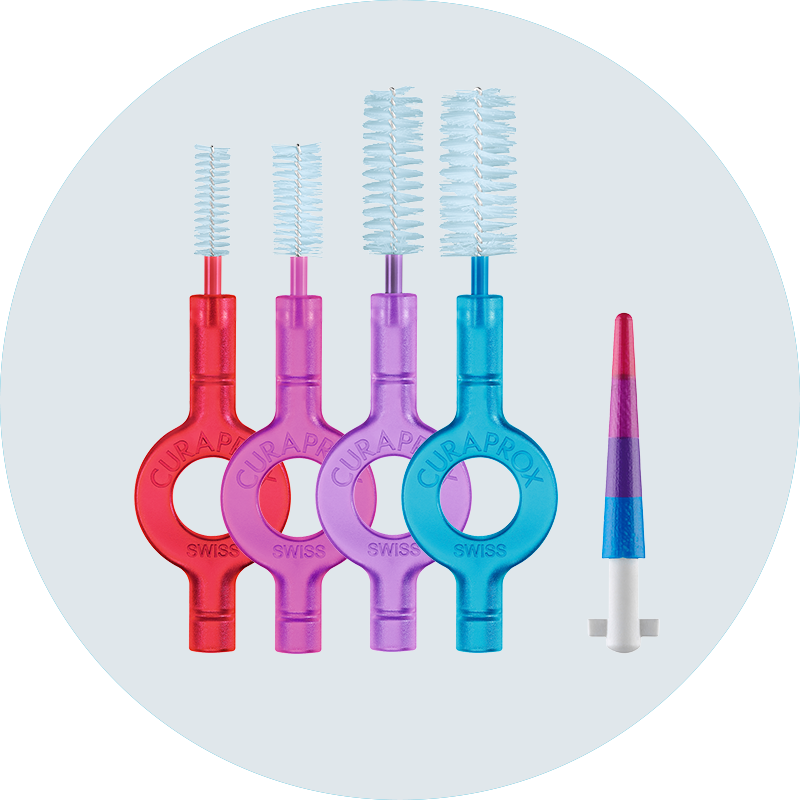The highest level of Interdental Brushing
Trusted by dental professionals worldwide to support optimal oral hygiene and long-term periodontal health.
.png?width=990&height=1480&name=IDB%20HS%20Landing%20Page%20v3%20-%20Mobile%20(1).png)
Engineered for precision, recommended by experts.
We understand that effective interdental cleaning is essential to preventing caries, gingivitis, and periodontitis. That’s why our interdental brushes are engineered to meet the highest clinical standards, with ultra-fine, densely packed filaments and surgical wire that effortlessly navigates tight interdental spaces without causing trauma. Whether you're educating patients or supporting periodontal therapy, our range offers the reliability and comfort professionals trust.
How to select the correct Interdental Brush
For every gap, for every patient
CPS Prime

CPS Prime - for primary prevention.
- Ideal for small, intact interdental spaces
- CPS 06 prime is the smallest IDB in the world
- Extra long, extra soft bristles
- Surgical wire (nickel-free)
- Excellent durability
CPS Perio

CPS Perio - for secondary prevention.
- Ideal for open, exposed interdental spaces
- For patients with periodontitis
- Perfect balance between softness and strength
- Highly resilient and durable thanks to a stronger wire core
- Excellent durability
Cleaning interdental spaces correctly.
Cleaning your teeth? – Of course! Fortunately, it is part of most people's daily routine. But be honest: How much attention do you pay to the spaces between your teeth? Do you really clean them sufficiently? You definitely should do, as cavity-causing bacteria love to colonise these areas of your mouth. Further, they are impossible to reach with a normal toothbrush.
How to use the Interdental Brush
Staying on the healthy side
They should ideally be embraced early on in life and used ever after: Curaprox interdental brushes. The small, ergonomically designed tools made from thin Cural® wire and long, fine filaments have stood the test of time. Thanks to the ultra-thin, low in nickel, and yet extra-strong surgical wire, the filaments are very mobile, enabling thorough cleaning – even in the narrowest interdental spaces. Like umbrellas, they stretch out to fill the gaps and provide a proper clean. The interdental access probes make it possible to determine the correct size precisely, with the prime and perio lines in different diameters covering a wide range of needs.
Become an Expert in the field
As a dentist, it is essential to specialize in the use of interdental brushes and ensure that both you and your patients are using the appropriate brush size. By practicing ourselves, we perfect our skills and can pass on the most effective methods to our patients.
Actively guide your patients
The most immersive teaching methods are those that engage all the senses, with touch being particularly central. A more intense understanding of learning occurs when the patient can actually feel what is expected of them. A purely verbal model for imparting knowledge is not enough.
Explain to your patients why their gums are bleeding
Many patients fear bleeding gums and assume they should avoid the triggering action. It is our job to educate them and correct this thought pattern. Then the patient will also realize that the use of interdental brushes is of paramount importance.
Rewarding patients
Rewards increase our motivation to continue desired actions. But first we should clearly communicate to our patients what steps are necessary for this reward. For example, as an incentive, you could offer your patient a free Curaprox 5460 toothbrush at their next consultation if they reduce bleeding gums when brushing their teeth.
Do you want to apply for a FREE Chariside Kit for your office?
Frequently asked Questions
Follow these three steps:
1. Place the brush on the gum line
2. gently push it all the way through.
3. Then out. Done!
Go to your dentist and have your interdental spaces measured with our IAP. If it is not possible to have them measured professionally, get a «CPS prime start mixed pack». Start with the smallest brush. Place the brush on the gum line, and gently push it all the way through. If you can easily insert an interdental brush, without using any pressure – that is >not the right size, it is smaller than needed. With the right size, a gentle push is required. Do not use force when inserting the brush!
We recommend using it once a day, in the evening before brushing your teeth. It can be in the evening, but also after lunch while watching a movie or reading a book.
This is not recommended for most people. If a patient suffers from severe gingivitis or periodontitis, they may use «Perio plus gel».
Every interdental space is different. With the calibration of interdental spaces, we check which interdental brush is the perfect fit for each interdental space. Because if the size is not properly calibrated for each interdental space, cleaning is not ideal. If the brush size is too small, the filaments will not reach all critical areas in the interdental space – will not spread up to the contact point, sulcus, and KOL. If a brush is too big, it will not fit and there is a risk of damaging the gums.
This depends on the brush and the user. In general, a brush can be used once a day for 1 up to 2 weeks. Change the brush, when the bristles start to look worn or shabby, or if the wire starts to bend or twist.
- Excellent durability of the Cural® wire
- Very soft and elastic filaments
- Click System
- IAP measuring system
All bacteria and microbiomes are already present in the mouth, so there is no procedure to ensure that bacteria from one area of the mouth do not enter another area (naturally, with saliva, the tongue...). By using an interdental brush, the patient disrupts the interdental biofilm - the bacteria are no longer associated with other bacteria in a structured, organized manner. They become planktonic - swimming alone in the mouth. The most dangerous types of bacteria - anaerobes, gram-negative bacteria that were at the bottom of the biofilm - die when the biofilm structure is interrupted.
Yes, there are studies that show the effectiveness of IDBs in reducing gingivitis. Effect of Triweekly Interdental Brushing on Bleeding Reduction in Adults: A Six-month Retrospective Study
That's because this is the thinnest wire we have. The thinner the wire, the easier it is to bend, of course.
This is a possibility for the future range of products. But in most cases, the dentist gives the patient the brush and holder he used during the treatment. Then it is easier for the patient to know which size/color he/she used and to continue the cleaning at home. It is also more hygienic to keep the IDBs in a holder with a protective cap.
Do you know our Professional Shop?
Explore our full range of products at our exclusive professional shop, designed specifically for our business clients.
Sign up now and get 10% off on your first order with the coupon code SIGNUP10*.
*One time use only, Minimum order USD 100, Order must be places online.
Sign up for our Newsletter now.
Stay up to date with the latest in oral health by subscribing to our newsletter. Get valuable information on dental care, exclusive offers, and helpful tips. You can unsubscribe at any time.
© CURADEN AG – All rights reserved
.png)